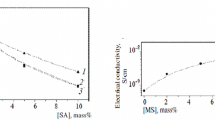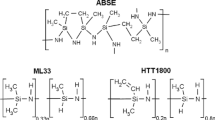Abstract
The possibility of fabrication was demonstrated and the basic technological parameters for spinning polysulfone fibres by the high-production melt method were determined. The polysulfone fibres developed were used as matrix and hybrid structures; thermostable composites with elevated physicomechanical properties were fabricated from such semifinished products.
Similar content being viewed by others
References
V. N. Smirnova et al., Khim. Volokna, No. 4, 20–21 (1990).
G. S. Golovkin, Fibre Technology for Processing Thermoplastic Composite Materials [in Russian], Izd. MAI, Moscow (1993).
S. V. Kotomin, E. V. Baidyukova, and E. M. Sapozhnikov, Khim. Volokna, No. 5, 45–46 (1992).
Author information
Authors and Affiliations
Additional information
V. V. Gorlov participated in fabrication of the hollow fibres.
Translated from Khimicheskie Volokna, No. 6, pp. 29–31, November–December, 1994.
Rights and permissions
About this article
Cite this article
Kotomin, S.V., Ignatenko, T.I. & Kostrov, Y.A. Spinning of hollow and matrix fibres from polysulfone melt. Fibre Chem 26, 374–376 (1995). https://doi.org/10.1007/BF00554395
Issue Date:
DOI: https://doi.org/10.1007/BF00554395




